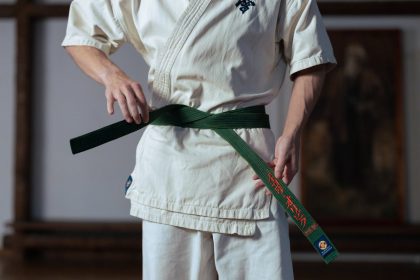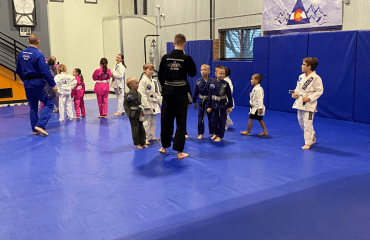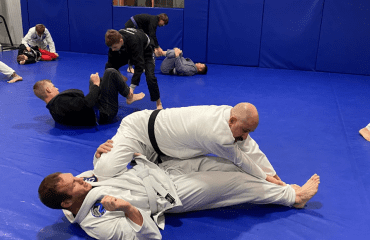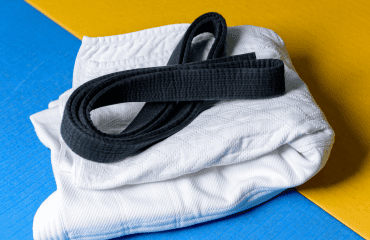
At our academy, Noco Jiu-Jitsu and Self-Defense, we understand the significance of achieving the green belt level in Brazilian Jiu-Jitsu (BJJ) for kids. It’s a pivotal moment that marks the transition from basic understanding to a deeper exploration of BJJ’s complexities. Mastering self-defense techniques at this stage is not just about physical prowess; it’s about building a foundation of discipline, respect, and a lifelong love for learning. Our goal is to guide young practitioners through this path, equipping them with the essential skills and values needed to thrive not only on the mats but in life.
Understanding BJJ’s Core Values at the Green Belt Level
The progression to a green belt in Brazilian Jiu-Jitsu (BJJ) marks a significant phase in a practitioner’s path, offering profound insights into the sport’s ethical framework. This stage is critical for young learners as it shapes their understanding and application of BJJ’s foundational values. Key among these values are respect, discipline, and an unwavering commitment to lifelong learning. These principles not only enhance their prowess on the mat but also contribute to their personal development off it.
Respect: The Foundation of BJJ Culture
- Understanding Hierarchies: Respect in BJJ extends beyond mere politeness; it’s about recognizing and appreciating the hierarchy within the dojo. This includes honoring the expertise and guidance of instructors and valuing the companionship and challenges posed by fellow students.
- Respect for the Dojo: Beyond people, respect is also accorded to the physical space of training. This encompasses maintaining cleanliness, observing silence during instruction, and appreciating the dojo as a sanctuary for growth.
- Respect in Competition: Young practitioners learn that respect carries through to competitions, where they must show sportsmanship towards opponents, referees, and spectators, embodying the ethos of BJJ in every interaction.
Discipline: The Path to Mastery
- Regular Practice: Discipline in BJJ is about the commitment to regular, focused practice. It’s the discipline to attend classes even when motivation wanes, understanding that growth is a product of consistent effort.
- Self-Control: Discipline also extends to self-control over emotions and actions. Practitioners learn to manage frustrations, channeling emotional energy into their training and improvement.
- Goal Setting: Effective discipline involves setting realistic goals and diligently working towards them. This process teaches young practitioners the importance of perseverance and strategic planning in achieving success.
Continuous Learning: A Lifelong Endeavor
- Openness to Feedback: A key aspect of continuous learning is the ability to receive and act on feedback. This openness transforms critiques into valuable lessons, fostering an environment where improvement is always possible.
- Adaptability: The green belt level highlights the need for adaptability—both in technique and in mindset. As practitioners face new challenges, they learn the importance of being flexible and creative in their approaches.
- Curiosity and Exploration: Encouraging curiosity about different techniques and strategies is essential for continuous learning. Practitioners are motivated to explore various aspects of BJJ, fostering a deeper understanding and appreciation of the art.
The path to obtaining a green belt in BJJ is more than just an accumulation of skills; it’s an immersive experience that instills respect, discipline, and a love for continuous learning. These core values shape practitioners not just as athletes but as individuals, preparing them for the many challenges and triumphs that lie ahead in both BJJ and life.
Essential Techniques for Young Green Belts
For children who have achieved the green belt level, it is vital to develop a comprehensive skill set that includes both offensive and defensive tactics. Here’s an expanded look at the techniques and strategies that are fundamental for young martial artists at this stage of their path.
Offensive Techniques:
- Guard Passing: Young green belts should become proficient in bypassing their opponent’s guard using techniques such as the knee slide, pressure pass, and the X-pass. This skill is essential for advancing to more dominant positions and setting up submissions.
- Control Positions: Achieving and maintaining control positions such as mount, side control, and back control are critical. Students should learn how to transition smoothly between these positions to maintain dominance over their opponent.
- Submissions: Developing a solid foundation in basic submissions is crucial. This includes armlocks, such as the armbar, and chokes, like the rear-naked choke and the guillotine choke. Understanding the mechanics and timing for these submissions can significantly improve a young practitioner’s offensive capabilities.
- Striking Techniques: While not always the focus in traditional grappling arts, incorporating basic striking techniques (for styles that include them) can be beneficial. Learning proper form and timing for punches, kicks, and other strikes can provide a more well-rounded skill set.
- Combination Attacks: Students should learn to chain attacks together, transitioning smoothly from one technique to another. This can include combinations of strikes leading to takedown attempts or stringing together multiple submission attempts to overwhelm an opponent.
Defensive Techniques:
- Escaping Disadvantageous Positions: Essential skills include escaping from the mount, side control, and back control. Practitioners should focus on techniques that allow them to safely regain a more neutral or advantageous position.
- Defending Against Strikes: For disciplines that incorporate striking, learning to block, dodge, and counter strikes is fundamental. This includes understanding the range and timing of different strikes and how to respond effectively.
- Submission Defense: Young athletes must learn to recognize and defend against common submissions. This includes understanding the early signs of a submission attempt and knowing the correct escape techniques.
- Improving Guard: Having a strong guard is a key defensive tool. Students should work on maintaining their guard under pressure and using it to neutralize their opponent’s attacks.
- Situational Awareness: Beyond specific techniques, developing situational awareness on the mat is critical. Practitioners should learn to anticipate their opponent’s moves and adjust their strategy accordingly.
By focusing on these enumerated offensive and defensive techniques, young green belts can significantly enhance their performance and confidence in martial arts. It’s important for instructors to provide a balanced training regimen that addresses both aspects to foster well-rounded development in their students.
The Importance of Physical Fitness in Kids’ BJJ Training
Physical fitness is paramount for children participating in Brazilian Jiu-Jitsu (BJJ), as it significantly impacts their ability to learn and perform within the sport. Strength, flexibility, and endurance are foundational elements that not only enhance their technical prowess but also safeguard against injuries. Incorporating age-appropriate exercises, such as bodyweight movements, yoga, and cardiovascular activities like swimming or running, can provide a well-rounded physical conditioning. These exercises are not only instrumental in building a solid physical foundation but also in instilling discipline, perseverance, and a healthy lifestyle from an early age.
The benefits of a structured fitness regimen extend beyond the mats; they contribute to the overall development of young practitioners into resilient and well-rounded individuals. Strength training helps in executing techniques and controlling opponents, while flexibility aids in injury prevention and the smooth execution of movements. Endurance training, on the other hand, is crucial for maintaining energy levels during extended training sessions and competitions. Together, these components of physical fitness prepare young athletes for the demands of BJJ, teaching them valuable life skills and instilling a sense of responsibility towards maintaining their physical health.
Advanced Guard Techniques for Kids
In the developmental path of young Brazilian Jiu-Jitsu (BJJ) practitioners, particularly those who have reached the green belt level, introducing advanced guard techniques marks a crucial phase in enhancing their grappling prowess. This training segment focuses on teaching kids the nuances of executing effective sweeps to transition from defense to offense, securing various submissions from the guard, and employing strategies to maintain a strong guard against aggressive adversaries. These advanced techniques are pivotal not just for gaining a competitive edge but also for deepening their strategic understanding of BJJ. Through learning to leverage sweeps, apply submissions, and maintain a defensive guard, young athletes develop a more comprehensive grasp of the sport’s tactical elements.
The emphasis on sweeps teaches kids the critical aspects of timing and leverage, essential for overturning opponents’ positions. Submissions from the guard, including armlocks, chokes, and leglocks, are introduced as offensive tools that can be executed from a seemingly defensive position, encouraging kids to perceive the guard as a potent attack platform. Additionally, strategies for maintaining a strong guard focus on using legs, hips, and grip control effectively to manage the distance and create a formidable defense. This comprehensive approach not only improves their performance in competitions but also instills a deeper strategic insight, laying a solid foundation for their ongoing growth in Brazilian Jiu-Jitsu.
Learning to Escape and Defend
Mastering escape techniques and defense mechanisms is crucial for children involved in self-defense and competitive environments. Training young individuals in the art of escaping from common holds and ensuring their safety during confrontations can significantly contribute to their confidence and competence. This section will explore deeper into the importance of escape and defense mechanisms, providing actionable strategies and techniques.
- Fundamentals of Escape Techniques
- Understanding Leverage and Timing: Teaching children the importance of leverage and the right timing to apply escape techniques can make a significant difference in their ability to free themselves from holds.
- Practicing from Different Positions: Regular practice from various positions such as the mount, guard, and side control can help kids become versatile in their escape capabilities.
- Drills for Quick Reaction: Incorporating drills that enhance quick reaction times to initiate an escape can prepare kids for unexpected situations.
- Defense Mechanisms Against Common Holds
- Wrist Releases: Simple yet effective techniques to release oneself from wrist grabs should be a staple in self-defense training for kids.
- Escape from Headlocks: Teaching how to safely escape from headlocks without causing harm to themselves or the opponent is vital.
- Defending Against Bear Hugs: Strategies to break free from bear hugs, focusing on creating space and using their weight to their advantage.
- Psychological Aspects of Defense
- Staying Calm Under Pressure: Encouraging kids to maintain composure and think clearly when in a challenging position can enhance their ability to escape.
- Awareness and Anticipation: Developing a keen sense of awareness and the ability to anticipate an opponent’s moves can be a game-changer in defense.
- Role of Physical Conditioning
- Strength Training: Incorporating age-appropriate strength training to support effective escape and defense techniques.
- Flexibility and Mobility: Enhancing flexibility and mobility can aid in executing escape techniques more efficiently.
- Ethics and Responsibility
- Using Skills Wisely: Emphasizing the importance of using self-defense skills responsibly and in defense only, fostering respect and discipline.
- Understanding the Impact of Actions: Teaching kids to understand the consequences of their actions during physical confrontations.
By focusing on these areas, children can develop a comprehensive understanding and skill set in escaping and defending, equipping them with the confidence to handle adversities in competitive settings and real-life situations.
The Role of Practice and Sparring for Young Practitioners
Regular drilling and sparring sessions stand as the cornerstone for enhancing the abilities of young Brazilian Jiu-Jitsu (BJJ) athletes. These exercises provide a golden opportunity for learners to put into action the techniques they’ve been taught in a setting that is both controlled and closely watched. This method of practice is crucial for instilling a concrete understanding of how BJJ techniques unfold in real-life scenarios. By specifically designing these sessions to meet the unique requirements of young enthusiasts, focusing on elements of enjoyment and safety, we lay down a foundation for steady engagement and development in the sport.
Adding to the benefits, engaging young learners in these practical sessions helps in building their confidence on and off the mats. It teaches them valuable life skills such as discipline, respect, and perseverance. By facing challenges during sparring, they learn to manage setbacks and celebrate successes, which are critical lessons in resilience. This hands-on approach to learning BJJ not only enhances their physical capabilities but also nurtures their mental toughness, preparing them for various life situations. Tailoring the practice to be age-appropriate ensures that they remain motivated and continue to see progress in their path, making the sport a fulfilling part of their routine.
Incorporating Takedowns and Throws in Kids’ BJJ
Takedowns and throws are critical components of Brazilian Jiu-Jitsu (BJJ), offering young practitioners a comprehensive grappling skill set. These techniques are essential, not just for competitions but also as foundational elements for effective self-defense. For children, mastering these aspects of BJJ can significantly enhance their overall proficiency and confidence both on and off the mat. This article will explore methods to incorporate takedowns and throws into kids’ BJJ training, emphasizing the importance of safety, proper form, and the development of essential physical attributes.
Understanding the Role of Takedowns and Throws in Kids’ BJJ
Takedowns and throws serve as the bridge between standing combat and ground fighting, two critical phases in BJJ. Introducing these techniques to children is vital for a rounded understanding of the sport. By learning how to safely bring an opponent to the ground, young BJJ students gain an advantage that complements their ground-fighting skills. This knowledge not only prepares them for competitive BJJ matches but also instills a practical skill set for self-defense situations.
Safety First: Ensuring a Secure Learning Environment
When teaching children how to perform takedowns and throws, the top priority must be their safety. This involves creating a supportive environment where students feel comfortable trying new moves without fear of injury. Instructors should emphasize the importance of proper technique over strength to avoid accidents. Mats and protective gear should be utilized to minimize the risk of injury, and close supervision is necessary to correct improper form immediately.
Building a Solid Foundation: Focus on Balance and Timing
The effectiveness of takedowns and throws heavily depends on balance and timing. Young practitioners should be taught how to maintain their balance while disrupting their opponents’, making the execution of these techniques more effective. Drills that enhance coordination and timing can be incorporated into training sessions, gradually increasing in complexity as the students’ skills improve. This approach not only helps in mastering takedowns and throws but also develops attributes beneficial for all aspects of BJJ.
Technical Proficiency: Breaking Down the Mechanics
Understanding the mechanics behind each takedown and throw is crucial for executing them correctly. Instructors should break down each technique into manageable steps, allowing kids to grasp the fundamental principles behind the movements. Slow-motion drills and repetitive practice of individual components can help students internalize the techniques, making them second nature. This methodical approach aids in building a strong technical foundation, essential for advancing in BJJ.
Integrating Takedowns and Throws into Practice Sessions
Strategically incorporating takedowns and throws into practice sessions ensures that students get ample opportunity to apply these techniques in a controlled setting. This can be achieved through specific drills that simulate real-life scenarios, sparring sessions that start from a standing position, and dedicated classes focusing on these aspects of BJJ. Such integration helps students understand the practical application of takedowns and throws, enhancing their overall grappling strategy.
Cultivating Respect and Discipline Through Practice
Learning and practicing takedowns and throws teach children more than just physical techniques; it instills values of respect and discipline. The controlled environment required for safely practicing these moves emphasizes the importance of trust and mutual respect among practitioners. Children learn to control their power and movements, understanding that the goal is not to harm but to practice and improve together. This aspect of BJJ training is invaluable, contributing to the development of character as well as physical skills.
Building a BJJ Game Plan for Kids
Developing a Brazilian Jiu-Jitsu (BJJ) game plan is not just about mastering a series of moves; it’s about understanding how to apply these techniques strategically in real-time situations. For young practitioners, this means learning how to recognize their strengths and use them to their advantage while also identifying areas for improvement. Encouraging kids to build their own BJJ strategy helps them develop critical thinking and problem-solving skills that go beyond the mat. Here’s how young practitioners can start building their BJJ game plan, focusing on leveraging their strengths:
- Start with the Basics: Before diving into complex strategies, ensure that kids have a solid grasp of BJJ fundamentals. Basic positions, escapes, and submissions form the foundation of any good game plan. Encouraging practice and repetition of these core techniques helps build muscle memory and confidence.
- Encourage Self-Assessment: Help kids understand their physical and mental strengths. Are they quick and agile, or are they more powerful and deliberate? Do they excel in a particular position or submission? Understanding these strengths allows them to focus on techniques that naturally suit their style.
- Strategic Sparring Sessions: Incorporate sparring sessions that focus on specific scenarios or positions. This approach helps kids apply their techniques in a controlled environment, where they can experiment with what works best for them and adjust their strategies in real-time.
- Video Analysis: Use videos of matches or sparring sessions to analyze performances. This can be an effective way to identify strengths and areas for improvement. Watching high-level athletes and breaking down their matches can also provide inspiration and insight into successful strategies.
- Set Short-Term Goals: Setting achievable, short-term goals related to their game plan can motivate kids and provide a clear direction for their training. Whether it’s mastering a new technique or improving their defense in a particular position, having specific objectives helps focus their efforts.
- Emphasize Flexibility and Adaptability: Teach kids that a good game plan is not rigid. Encourage them to be flexible and adapt their strategies based on their opponent’s actions. This adaptability is key to overcoming unexpected challenges during a match.
- Mental Preparation: Beyond physical techniques, mental resilience plays a crucial role in competition. Teach kids visualization techniques and positive self-talk to boost their confidence and help them stay focused under pressure.
- Foster a Supportive Environment: Encourage teammates to share their experiences and strategies. A supportive team environment fosters learning and improvement, as kids can learn a lot from each other’s successes and mistakes.
By focusing on these areas, young BJJ practitioners can develop a well-rounded game plan that leverages their individual strengths. This not only enhances their performance on the mat but also contributes to their growth as confident, strategic thinkers.
Developing Mental Resilience and Handling Challenges
Brazilian Jiu-Jitsu (BJJ) challenges participants not only physically but also mentally, especially for children progressing to the green belt level. It’s imperative to equip kids with the mental tools needed to stay driven, process defeats, and surmount challenges. Mental resilience in BJJ can be cultivated through various strategies, ensuring young practitioners not only excel on the mats but also develop skills beneficial for life outside the dojo.
- Setting Achievable Goals: Begin with establishing small, manageable objectives that children can reach. This approach helps maintain their interest and gives them a sense of accomplishment, which is crucial for motivation. For instance, mastering a new grappling technique or improving their performance in specific drills can be excellent goals.
- Fostering a Positive Training Environment: The atmosphere in which children train significantly affects their mental attitude. A supportive and encouraging environment can inspire kids to push beyond their limits. Coaches and parents should focus on positive reinforcement, celebrating improvements and effort rather than just victories.
- Emphasizing the Importance of Effort Over Outcomes: It’s vital for young athletes to understand that effort is more valuable than winning. This mindset encourages them to focus on personal development and learning rather than the pressure of outcomes. Acknowledging their hard work, regardless of the match result, builds resilience and a healthy approach to competition.
- Building a Support System: Having a strong support system of coaches, family, and fellow athletes can significantly impact a child’s mental resilience. Knowing they have people to turn to for advice, encouragement, and comfort helps them feel less isolated with their challenges.
- Learning From Losses: Teaching kids to view losses as opportunities for growth rather than failures is a critical aspect of developing mental toughness. Analyzing what went wrong and what could be improved for next time turns defeat into a valuable learning experience.
Expanding the Mental Toolkit
In addition to the strategies mentioned, several other methods can further aid in the mental development of young BJJ practitioners:
- Visualization Techniques: Encourage kids to visualize their techniques and successes. This practice can improve focus, reduce anxiety before competitions, and enhance overall performance.
- Breathing Exercises: Simple breathing techniques can help manage stress, calm nerves, and maintain focus during training and competition.
- Mental Rehearsal: Regularly practicing mental rehearsal of matches or techniques can prepare children for various scenarios, boosting their confidence and adaptability.
- Positive Self-Talk: Teaching children to practice positive self-talk can significantly influence their confidence and mental state. Replacing self-doubt with affirmations strengthens their belief in their abilities.
- Mindfulness and Meditation: Introducing basic mindfulness and meditation can improve concentration, reduce stress levels, and enhance emotional regulation, contributing to a stronger mental game.
By incorporating these strategies into their training, children at the green belt level can develop a robust mental framework that supports their growth in BJJ and beyond. It’s about building a mindset that views challenges as steps towards improvement, transforming obstacles into opportunities for learning and development.
Preparing for the Brown Belt: Next Steps for Young BJJ Athletes
Young Brazilian Jiu-Jitsu (BJJ) athletes looking forward to their brown belt face a critical phase in their development. This period is not just about acquiring new techniques but also about honing existing skills, understanding deeper strategies, and preparing mentally and physically for advanced challenges. Here’s how they can effectively prepare for this next level:
- Refine Existing Techniques: It’s essential to perfect the techniques learned up to the green belt level. Practitioners should focus on precision and efficiency, ensuring that their movements are both effective and conserve energy.
- Develop a Deeper Strategic Understanding: Moving towards the brown belt requires a deeper understanding of BJJ strategies. Athletes should study advanced positions and transitions, learning how to anticipate and counter opponents’ moves.
- Strengthen Physical Conditioning: Advanced BJJ training demands a high level of physical fitness. Young athletes should incorporate strength, flexibility, and endurance training into their routines to improve their performance on the mat.
- Engage in Competitive Sparring: Regular sparring with peers and more experienced practitioners provides invaluable experience. It helps in applying techniques under pressure and exposes athletes to a variety of styles and strategies.
- Cultivate Mental Toughness: The mental aspect of BJJ becomes increasingly important at higher belt levels. Practitioners should work on their focus, resilience, and ability to stay calm under pressure, which are crucial for success in competition and training.
- Seek Feedback and Mentorship: Continuous improvement often requires external insights. Young athletes should seek feedback from coaches and mentors, taking constructive criticism to heart and using it to guide their training.
- Study BJJ Philosophy and History: Understanding the history and philosophy of BJJ can provide additional motivation and context for training. It helps athletes appreciate the art’s depth and the importance of respect, discipline, and persistence.
- Prioritize Recovery and Nutrition: As training intensity increases, so does the need for proper recovery and nutrition. Athletes should adopt healthy eating habits and ensure they get adequate rest to support their physical and mental recovery.
- Set Short-Term and Long-Term Goals: Setting goals can help athletes stay motivated and focused. These should include both short-term objectives, such as mastering a new technique, and long-term aspirations, like competing at higher levels.
- Emphasize the Importance of Respect and Etiquette: Respect for coaches, fellow athletes, and the art of BJJ itself is fundamental. Practitioners should always train with humility and a willingness to learn, fostering a positive and supportive training environment.
By focusing on these areas, young BJJ athletes can prepare themselves for the challenges of the brown belt and beyond, building a strong foundation for continued growth and success in the sport.
Engaging with the BJJ Community and Fostering Continuous Learning
Participating in the BJJ community through youth seminars, competitions, and social events can greatly enhance a young practitioner’s experience. At Noco Jiu-Jitsu and Self-Defense, we encourage our students to embrace these opportunities for growth, networking, and fun. The importance of lifelong learning in martial arts cannot be overstated, and engaging with the broader BJJ community is a fantastic way to foster this mindset.
- Increased Exposure to Diverse Techniques: By engaging with the BJJ community, practitioners are exposed to a wide range of techniques and styles. This exposure is crucial for developing a well-rounded skill set and understanding the depth of Brazilian Jiu-Jitsu. Youth seminars and workshops provide an excellent platform for this, as they often feature guest instructors with unique insights and techniques.
- Building a Supportive Network: The friendships and connections made through BJJ extend beyond the mats. Competitions, seminars, and social gatherings are perfect venues for networking with fellow practitioners who share similar goals and challenges. This network can provide support, motivation, and advice, contributing significantly to a young athlete’s growth and development.
- Enhancing Competitive Skills: Active participation in competitions offers invaluable experience in dealing with pressure, strategizing against opponents, and adapting to unpredictable situations. Competing against a variety of opponents sharpens a practitioner’s ability to apply techniques effectively and boosts their confidence in their skills.
- Fostering a Sense of Community and Belonging: Being part of the BJJ community fosters a strong sense of belonging and identity among practitioners. This community support is essential for maintaining motivation and enthusiasm for the sport, especially during challenging times.
- Learning from the Successes and Failures of Peers: Observing and discussing the experiences of peers within the community offers practical lessons in resilience, determination, and strategy. Success stories inspire, while failures teach valuable lessons on what to avoid and how to improve.
Engaging with the BJJ community and prioritizing continuous learning are key elements for success in Brazilian Jiu-Jitsu. At Noco Jiu-Jitsu and Self-Defense, we strive to provide our students with ample opportunities to connect with the community and learn from diverse experiences. We believe that these experiences not only enhance their skills but also enrich their lives beyond the mats.
At Noco Jiu-Jitsu and Self-Defense, we are committed to guiding our young practitioners through their BJJ path with enthusiasm and dedication. Mastering the essential skills and values at the green belt level sets the stage for a rewarding path in martial arts. We encourage our students to pursue their training with relentless enthusiasm and unwavering dedication, reminding them that every challenge faced on the mats is a step toward personal growth and martial excellence. Embrace the adventure, cherish the community, and continue to learn every day.
Enroll in our specialized classes for kids, participate in youth workshops, or join the Noco Jiu-Jitsu club today. Enhance your skills, connect with a supportive community, and become part of something bigger than yourself. Don’t miss this opportunity to grow, learn, and excel in Brazilian Jiu-Jitsu. Contact us now to start on your empowering path with Noco Jiu-Jitsu and Self-Defense. Let’s make your BJJ dreams a reality together.




